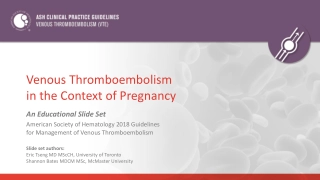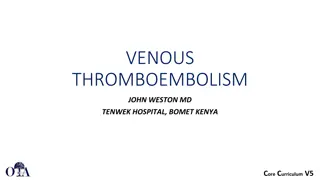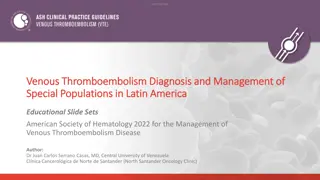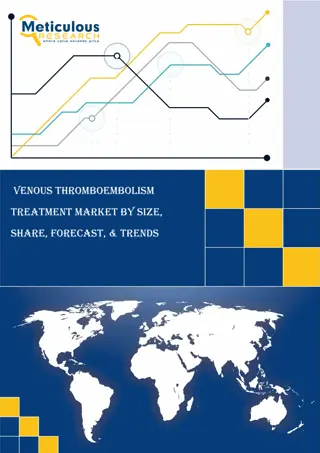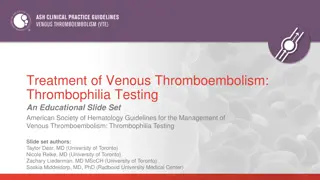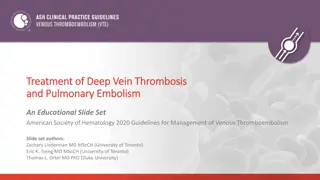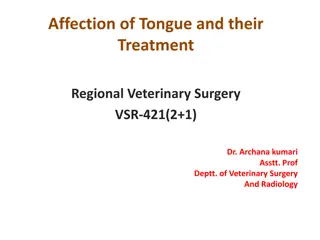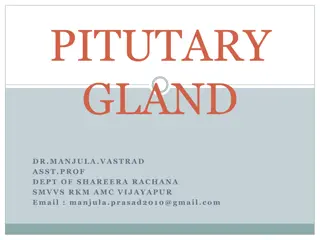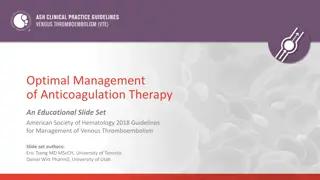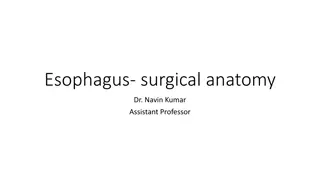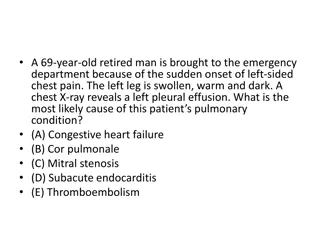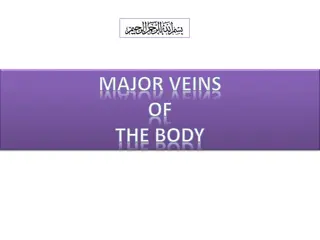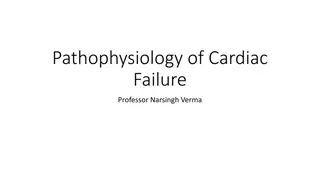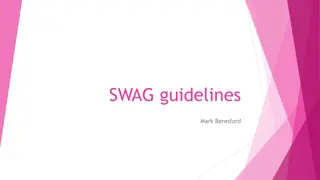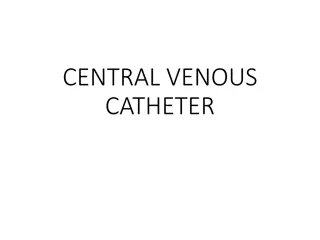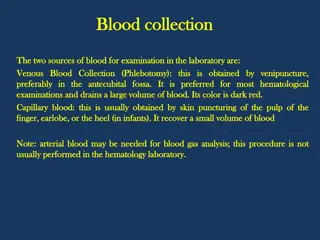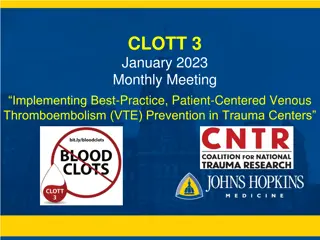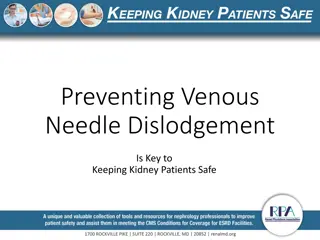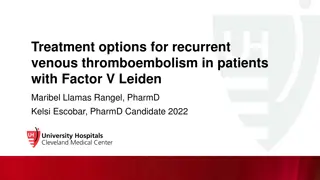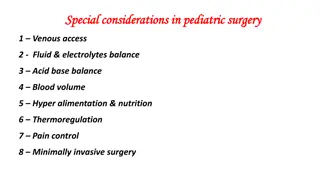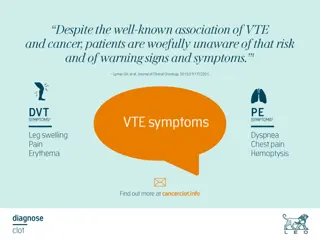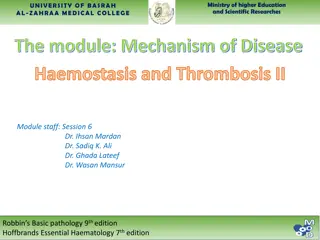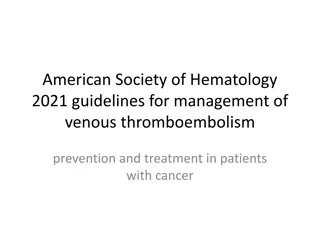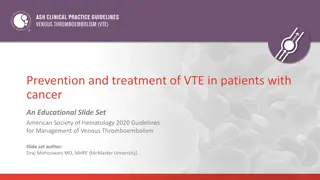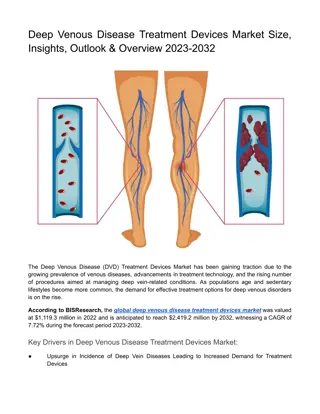Venous Thromboembolism in the Context of Pregnancy
Key guidelines from the American Society of Hematology (ASH) in 2018 focus on managing venous thromboembolism in pregnancy. The guidelines cover prevention, treatment, and optimal management of VTE in various clinical settings. Panels formed for guideline development included diverse expertise to en
1 views • 49 slides
Understanding Venous Thromboembolism in Orthopedic Patients
This educational content covers the basics of deep vein thrombosis (DVT) and pulmonary embolism (PE), including definitions, pathophysiology, risk factors, prevention strategies, diagnosis, and treatment. Traumatic and non-traumatic risk factors for VTE in orthopedic patients are discussed, emphasiz
0 views • 36 slides
Venous Thromboembolism Diagnosis and Management in Latin America: ASH 2022 Educational Slide Sets
The American Society of Hematology (ASH) 2022 guidelines for the diagnosis and management of venous thromboembolism in special populations in Latin America are presented in educational slide sets authored by Dr. Juan Carlos Serrano Casas and other experts. The Latin American ADOLOPMENT project, a co
0 views • 52 slides
Central Venous Catheter Access Management in Brampton and Surrounding Areas
Nurse-led Outreach Team in Brampton, North Etobicoke, West Woodbridge, Malton, and Bramalea provides education on managing central venous catheter access devices like PICCs. Learn about preventing infections, post-insertion care, types of CVADs, and aseptic techniques for PICC line management.
1 views • 20 slides
Understanding Coronary Artery Bypass Graft (CABG) in Adult Nursing
Coronary Artery Bypass Graft (CABG) is a surgical procedure where a blood vessel from another part of the body is grafted onto an occluded coronary artery to bypass blockages. This procedure is less common in women compared to men and is typically indicated for severe coronary artery disease. It is
5 views • 15 slides
Understanding Central Venous Line (CVL) and Central Venous Pressure (CVP) Monitoring
Central Venous Line (CVL) and Central Venous Pressure (CVP) monitoring play critical roles in intensive care settings. This article covers the indications, types, insertion sites, and contraindications of CVL. It also explains the significance of CVP measurement and how to perform and interpret it u
3 views • 40 slides
Venous Thromboembolism Market
Venous thromboembolism occurs when a blood clot forms in a vein, obstructing the blood flow and posing a potentially life-threatening risk. Several devices and drugs are employed for the prevention and treatment of venous thromboembolism. The devices considered within this scope are utilized for bot
5 views • 3 slides
Guidelines for Thrombophilia Testing in Venous Thromboembolism Management
The American Society of Hematology (ASH) provides comprehensive guidelines for the management of venous thromboembolism (VTE) with a focus on thrombophilia testing. Expert panels develop recommendations based on clinical questions, evidence synthesis, and resource use. These guidelines cover various
2 views • 47 slides
ASH Guidelines 2020: Management of Venous Thromboembolism
American Society of Hematology (ASH) released guidelines in 2020 for the management of Venous Thromboembolism, focusing on deep vein thrombosis and pulmonary embolism. These guidelines cover prevention, treatment, and optimal management strategies. The recommendations are developed through a rigorou
0 views • 45 slides
Understanding Cardiac Output and Venous Return in Cardiovascular Physiology
Cardiac output, stroke volume, end-diastolic and end-systolic volumes play vital roles in cardiovascular function. Factors affecting cardiac output include physiological conditions and pathological states like hyperthyroidism and myocardial infarction. Venous return, controlled by mechanisms like Fr
0 views • 27 slides
ASH Guidelines on Venous Thromboembolism in Pregnancy
The American Society of Hematology (ASH) 2018 guidelines provide comprehensive management recommendations for venous thromboembolism in pregnancy. Key aspects include panel formation, clinical questions generation, evidence synthesis, and making recommendations. The guidelines offer strong and condi
0 views • 49 slides
Treatment of Tongue Affections in Veterinary Surgery by Dr. Archana Kumari
In this educational material, Dr. Archana Kumari discusses various tongue affections in animals such as strangulation, smooth tongue, tumors, and ranula. Treatment methods for each condition are described in detail, providing valuable insights for veterinary surgeons. From managing venous engorgemen
0 views • 21 slides
Understanding the Intrinsic Muscles of the Tongue - Anatomy and Physiology Overview
In this detailed presentation by Dr. Sushma Tomar, Associate Professor of Anatomy, the intrinsic muscles of the tongue are explored, along with their functions, arterial and venous supply, lymphatic drainage, and nerve supply. The lecture covers the four intrinsic muscles in each half of the tongue,
1 views • 15 slides
Overview of Pituitary Gland: Structure, Function, and Relationships
The pituitary gland, also known as the hypophysis, is an endocrine gland located at the base of the brain. It is divided into two main parts: the adenohypophysis and the neurohypophysis. The gland plays a crucial role in hormone regulation and is closely related to neighboring structures such as the
0 views • 26 slides
Optimal Management of Anticoagulation Therapy - ASH 2018 Guidelines
The American Society of Hematology (ASH) 2018 guidelines focus on the optimal management of anticoagulation therapy, specifically in the context of venous thromboembolism (VTE). The guidelines cover topics such as prevention, treatment, and management strategies, developed through thorough panel for
0 views • 43 slides
Guidelines for Management of Pediatric Venous Thromboembolism
This educational slide set presents the American Society of Hematology's 2018 guidelines for the treatment of pediatric venous thromboembolism. The guidelines cover various aspects such as prevention, treatment, and optimal management of anticoagulation therapy in pediatric patients. Panels were for
0 views • 47 slides
Esophagus Surgical Anatomy Overview
This detailed overview of esophagus surgical anatomy covers the anatomical structure and relationships, constrictions, clinical importance, length, blood supply, venous drainage, and nerve supply. The content includes informative images and descriptions provided by Dr. Navin Kumar, Assistant Profess
0 views • 49 slides
Pulmonary Conditions and Hemodynamic Disorders: Clinical Cases
A 69-year-old man with chest pain and pleural effusion presents with thromboembolism; a 22-year-old worker with fractures develops shock due to fat embolism; a postpartum woman dies from amniotic fluid embolism. The cases illustrate conditions like pulmonary embolism, fat embolism, and amniotic flui
0 views • 26 slides
Overview of Veins and Venous Circulation in the Body
Veins play a crucial role in the circulatory system by carrying deoxygenated blood back to the heart. This lecture covers the general principles of veins, the anatomy of major veins like the superior and inferior vena cavae, tributaries, and their roles in different parts of the body. It also discus
0 views • 14 slides
Optimal Management of Anticoagulation Therapy: ASH 2018 Guidelines
Educational slide sets and clinical guidelines by the American Society of Hematology (ASH) provide recommendations for the management of venous thromboembolism, including the optimal use of anticoagulation therapy. The guidelines detail panel formation criteria, development process, evidence synthes
0 views • 43 slides
Pathophysiology of Cardiac Failure and Adaptive Mechanisms of the Heart
Cardiac failure is a condition where the heart is unable to meet tissue metabolic needs despite normal or increased venous return. Causes include decreased contractility, coronary blood flow, damaged valves, and more. Normal resting cardiac output is 5 Lt/mts, with adaptive mechanisms like the Frank
0 views • 35 slides
Extended Endocrine Therapy Guidelines for Breast Cancer Patients
Extended adjuvant endocrine therapy may benefit breast cancer patients with poor or intermediate prognosis, but may have little value for those with good prognosis. Risks include osteoporosis and venous thromboembolism. Different treatment options are available for postmenopausal and premenopausal w
0 views • 9 slides
Central Venous Catheters: Uses, Placement, and Indications
A central venous catheter (CVC) is a crucial medical device placed into a large vein for various purposes like administering medication, fluids, and obtaining blood tests. The catheter can be tunneled or non-tunneled, and specific sites are preferred for each type. Indications for CVC usage include
1 views • 19 slides
Pediatric Vascular Access Techniques and Considerations
This article discusses various vascular access methods in infants and children, including peripheral IV access, central venous access, arterial lines, and ultrasound-guided techniques. It covers indications, sites, complications, and techniques for each method, emphasizing the importance of proper a
1 views • 56 slides
Advances in Anticoagulation Therapy for Cancer-Related VTE and Stroke
Recent studies have shown advancements in anticoagulation therapy for cancer patients with venous thromboembolism (VTE) and stroke prevention. Direct oral anticoagulants (DOACs) are now considered beneficial for treating VTE in cancer, offering advantages in administration and efficacy. Different an
3 views • 9 slides
Evaluation of Risk Stratification Schemes for Ischaemic Stroke and Bleeding in Atrial Fibrillation Patients
A study conducted in Sweden on 182,678 patients with atrial fibrillation aimed to investigate risk factors for stroke and bleeding. The research assessed the application of CHA2DS2-VASc and HAS-BLED schemes for stroke and bleeding risk evaluations. Data from the Swedish Atrial Fibrillation cohort st
0 views • 20 slides
Portal Vein Imaging Techniques and Anomalies Overview
Portal vein imaging is crucial for evaluating conditions affecting the abdominal part of the gastrointestinal tract. Techniques such as spleno-portography and CT triphasic contrast imaging are used to visualize the portal vein and diagnose anomalies like portal-systemic collaterals and porto-systemi
4 views • 7 slides
Venous Blood Collection Methods and Equipment Overview
Venous blood collection techniques, including antecubital fossa and heel sticks, are commonly used for laboratory examinations. Venous blood is preferred for its large volume and ease of recovery. This article also explores the differences between capillary and venous blood samples in terms of compo
0 views • 8 slides
Implementing Best-Practice VTE Prevention in Trauma Centers
This document outlines the milestones and progress towards implementing a patient-centered Venous Thromboembolism (VTE) prevention program in trauma centers. It includes data collection, nurse education, real-time alert system finalization, patient-centered education interventions, milestone dates,
0 views • 21 slides
Overview of Jejunum and Ilium Histology and Vascular Supply
The jejunum and ileum are segments of the small intestine with distinct features in terms of position, diameter, wall thickness, and lymphoid aggregates. They receive arterial blood supply from branches of the superior mesenteric artery and drain into various venous tributaries. Histologically, the
0 views • 14 slides
Comprehensive Clinical Evaluation of Children with Cardiac Abnormalities
Initial clinical evaluation of a child with possible cardiac abnormalities includes history taking and physical examination. History should cover symptoms related to pulmonary and systemic venous congestion, cyanosis, cyanotic spells, palpitations, chest pain, and more. The general physical examinat
0 views • 65 slides
Understanding Venous Needle Dislodgement in Dialysis Patients
Venous Needle Dislodgement (VND) is a serious complication of hemodialysis that can lead to significant blood loss and even mortality. It occurs when the venous fistula needle becomes dislocated, resulting in blood loss ranging from minor to fatal. The risk factors, consequences, and frequency of VN
0 views • 30 slides
Retinal Imaging Conference - Case Study of Diabetic Patient with Blurry Vision
A 52-year-old African American female with a history of diabetes and hypertension presented with occasional blurry vision in her left eye. Examination revealed retinal thickening, cystic spaces, and disruption of retinal layers. Autofluorescence imaging showed hyperautofluorescence centrally and hyp
0 views • 27 slides
Treatment Strategies for Recurrent Venous Thromboembolism in Factor V Leiden Patients
This presentation discusses the treatment options for recurrent venous thromboembolism in patients with Factor V Leiden mutation. It explores the pathophysiology, epidemiology, and diagnosis criteria for Factor V Leiden, reviews failed anticoagulation history, and suggests outpatient anticoagulation
0 views • 31 slides
Pediatric Surgery: Special Considerations for Venous Access and Fluid Management
Pediatric surgery requires special attention to venous access and fluid management due to unique considerations in infants and children. Key aspects include methods for obtaining vascular access, monitoring fluid and electrolyte balance, and addressing specific fluid requirements based on age and we
0 views • 15 slides
Understanding the Association of Cancer and Venous Thromboembolism
VTE poses a significant risk for cancer patients, yet awareness of this link and its warning signs is lacking. The detection of VTE during cancer staging and its implications, including incidental findings and clinical correlates, highlight the need for proactive measures in managing this co-occurre
0 views • 5 slides
Understanding Embolism and Venous Thrombosis in Mechanism of Disease
Embolism, defined as a detached intravascular mass carried through the blood, poses serious risks like pulmonary embolism. Venous thrombosis, particularly deep vein thrombosis (DVT), can lead to embolization, emphasizing the importance of understanding these mechanisms in medical practice.
0 views • 40 slides
American Society of Hematology 2021 Guidelines for Venous Thromboembolism in Cancer Patients
The American Society of Hematology (ASH) 2021 guidelines provide recommendations for preventing and treating venous thromboembolism (VTE) in cancer patients. The guidelines cover primary prophylaxis for hospitalized medical patients and those undergoing surgery, emphasizing the use of thromboprophyl
0 views • 23 slides
Guidelines for Prevention and Treatment of VTE in Cancer Patients
American Society of Hematology's 2020 guidelines address the prevention and treatment of venous thromboembolism (VTE) in cancer patients. Developed by experts, these guidelines focus on key clinical questions, evidence synthesis, and recommendations for managing VTE in this specific population. The
0 views • 47 slides
Deep Venous Disease Treatment Devices Market
The global deep venous disease treatment devices market was valued at $1,119.3 million in 2022 and is anticipated to reach $2,419.2 million by 2032, witnessing a CAGR of 7.72% during the forecast period 2023-2032.\n\nRead Report Overview: \/\/bisrese
1 views • 3 slides
